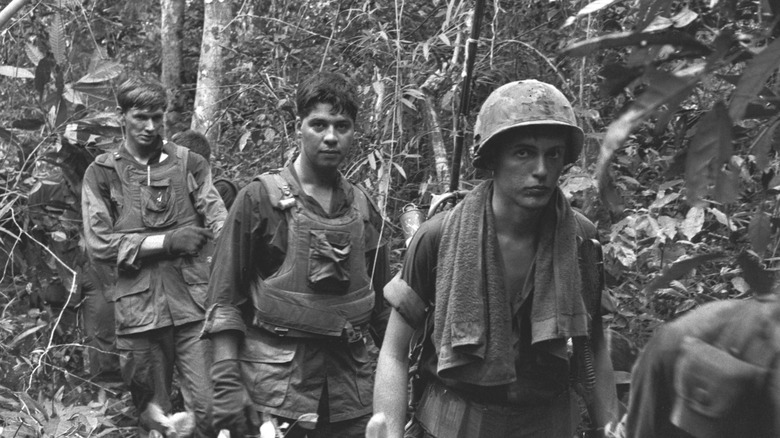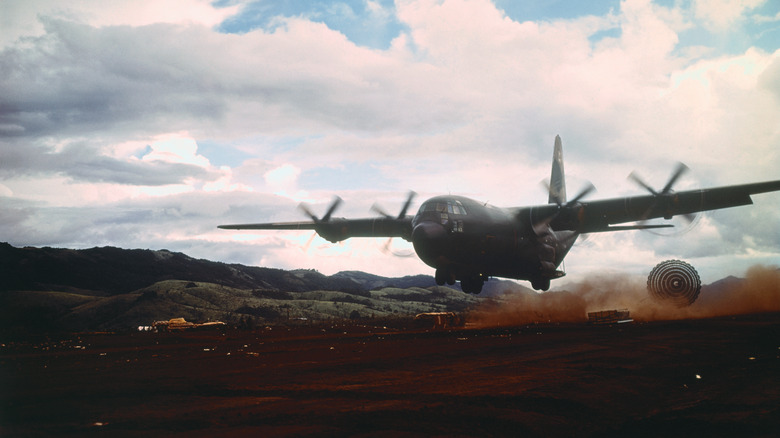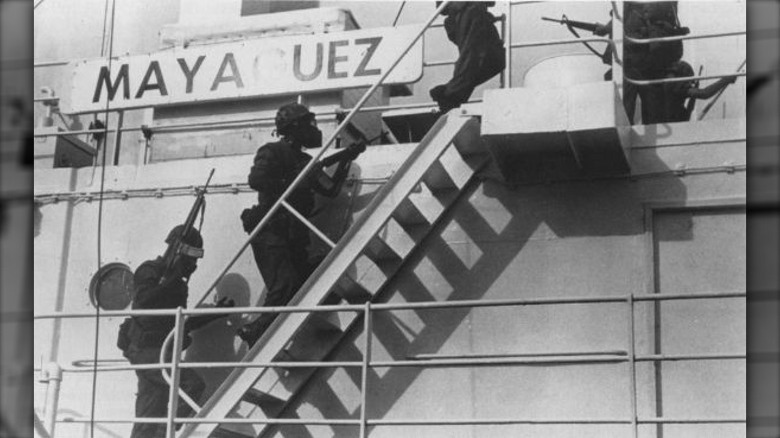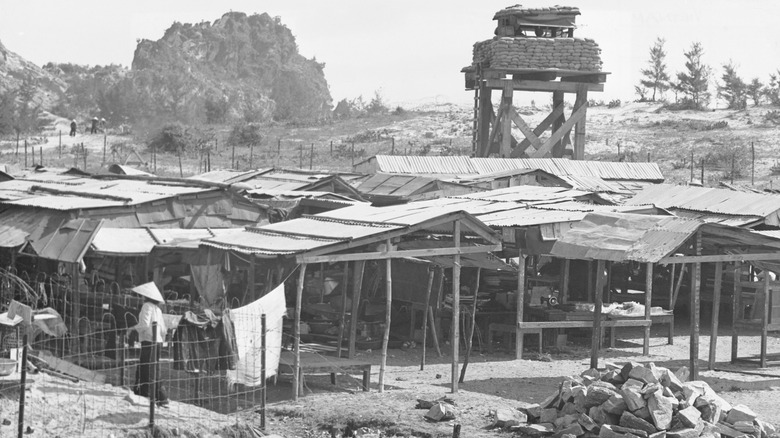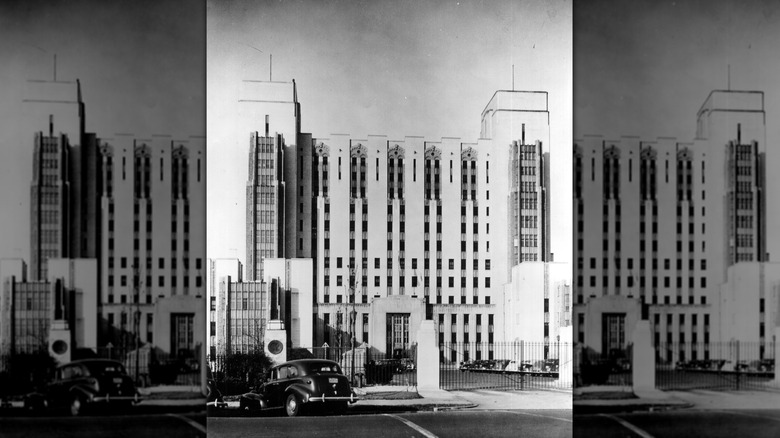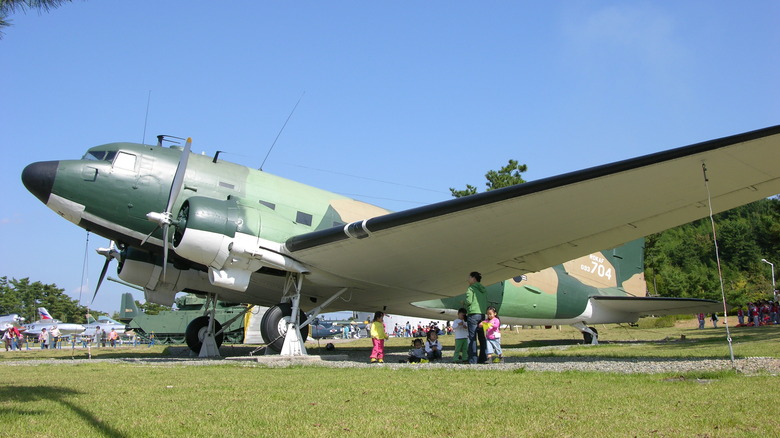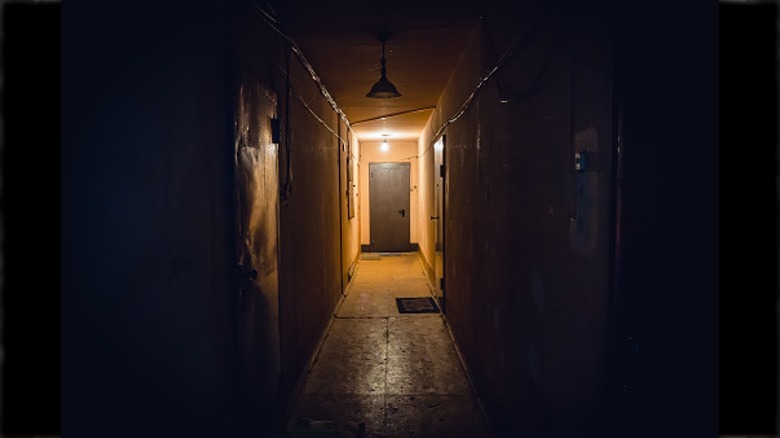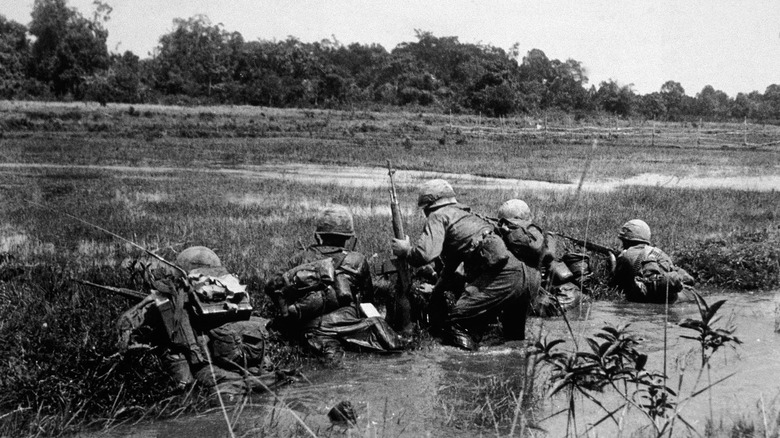The Most Bizarre Unsolved Mysteries Of The Vietnam War
It's no stretch to say that the Vietnam War was a rather controversial conflict, especially in the eyes of the American public. More generally speaking, though, this was largely a war perpetuated by communist North Vietnam against West-aligned South Vietnam and its allies (including the United States). The overall conflict ran from 1954 to 1975, with the North Vietnamese trying to unite both halves of the country under a communist flag, coming to a close with the fall of South Vietnam. Amidst all of that, however, the Vietnam War saw some messed up things, and, like many other wars throughout history, plays host to quite a few unsolved mysteries.
On the American side, though, it's a war that's mostly remembered for being wildly unpopular, characterized by guerilla warfare and heavy losses on all sides. U.S. military presence was already active in the 1950s, heavily increased throughout the 1960s (with official intervention beginning in 1965), and then ceased in 1973. Active protests played a part in that, as well as widespread disapproval and disillusionment regarding both the draft and the simple reason behind American involvement in the first place.
Swirling around in the murky waters of the history of the Vietnam War are scores of missing persons cases and inexplicable disappearances, apparent government cover-ups, and even the appearance of creatures seemingly conjured from nightmares. Decades have passed since all of that happened, but still, there are plenty of questions to go around. Here are a handful of those strange mysteries.
The disappearance of Flight 739
There are aviation mysteries aplenty, and Flying Tiger Line Flight 739 is one of the stranger ones. The cargo plane took off on March 15, 1962 — carrying 11 crew members and 96 passengers, all of whom had military connections to either the U.S. or South Vietnam — heading toward Saigon from Guam. All seemed fine for the first couple of hours, but then Flight 739 disappeared. By 8:22 a.m. on March 16, the plane and all its passengers were officially declared lost.
The past 60 years haven't uncovered any real answers to the persistent mystery. In truth, the only real clue was a report from the crew of a tanker ship who reported a bright explosion in the sky around 1:30 a.m. They saw two objects fall into the sea, but the following search (then among the largest ever) recovered absolutely no debris from the flight. Theories have swirled around, positing that the plane could've been tampered with in Guam, or maybe the plane and its passengers were actually captured.
But that's not where the oddities end. Families of the missing soldiers have spoken about their mistreatment at the hands of the U.S. government, which has long refused to add their names to the Vietnam Veterans Memorial and failed to provide any military service at the funerals. All of which just sounds even stranger considering the families have no idea what this mission was, though the soldiers were exceptionally worried; one even seemed convinced he wouldn't return home.
The Mayaguez Incident and its lost Marines
On the surface, the Mayaguez Incident just seems to be the final battle of the Vietnam War. On May 12, the American cargo ship the Mayaguez was attacked by Khmer Rouge forces. The crew did manage to get a distress signal out, though, and a few days later, the U.S. sent reinforcements to save the sailors, who had been taken to the nearby Cambodian island of Koh Tang.
The whole thing was a huge mess. The Marines were forced into a firefight against forces they weren't prepared for — despite the crew having been recovered before their arrival. In other words, they were fighting for literally no reason. All they could do was wait for a rescue. Eventually, helicopters picked them up, under the belief that all surviving Marines had been rescued.
That is, until later that night, when a radio call came in, a voice asking when the next helicopter would arrive. As it turned out, three Marines (Danny Marshall, Gary Hall, and Joseph Hargrove) were still stuck on the island, but the military refused to mount a rescue operation. The three men disappeared, and to this day, no one knows exactly what happened to them. Ex-Khmer Rouge commander Em Son has since claimed to find Hargrove stealing food, then killing and burying him under a mango tree; the other two were reportedly taken to officials on the mainland. But the U.S. military has refuted that story, and Son himself has changed his tale on multiple occasions. Not to mention that searches of the supposed burial site have turned up empty.
The first female POW in Vietnam
When it comes to missing persons and POWs taken during the Vietnam War, there are plenty of discussions to be had. After all, over 1,000 Americans are still unaccounted for, and discussions of bringing captured Americans home tended to be a pretty hot topic. One of the stranger cases, however, has to do with the disappearance of Dr. Eleanor Ardel Vietti in 1962.
Vietti acted as a medic in the Vietnam War, helping South Vietnam's Montagnard population with the Christian and Missionary Alliance, but on May 20, 1962, guerilla fighters appeared in the village. They ordered Vietti to go with them, tying up two other volunteers — Archie Mitchell and Dan Gerber — in the process. All three were taken, never to be seen again, but the reasons and circumstances have remained hazy. No ransom was ever made for their return, only adding to the confusion, though the higher-ups of the Christian and Missionary Alliance suspect the raid was directed toward obtaining more medical supplies.
But that doesn't change the fact that, beyond some hazy rumors, the fates of Vietti, Mitchell, and Gerber have never been determined. A Des Moines Tribune article from later in 1962 mentioned a captured guerilla fighter who actually referenced Vietti directly; reportedly, she was treating wounded Viet Cong soldiers and traveling alongside Mitchell and Gerber, all of them unharmed. A 1965 Battle Creek Enquirer article included very similar claims from Viet Cong prisoners; that all three were being shuttled from village to village to provide medical aid, but any attempts to make contact were apparently unsuccessful.
The murder of Robert Daniel Corriveau
Not all Vietnam War mysteries necessarily took place in countries that Americans might not be personally familiar with or against a backdrop of government conspiracy. Rather, some mysteries took place right in the United States, such as the fate of Robert Daniel Corriveau.
Corriveau was a decorated corporal in the Marines, wounded three times during the Vietnam War. In late 1968, he was back on American soil for treatment at the Philadelphia Naval Hospital, specifically regarding psychiatric treatment for symptoms arising from combat. (Possibly PTSD, though it wouldn't have an official name and diagnosis until after the war.) But on the night of November 18, Corriveau suddenly disappeared from the hospital, and the military labeled him a deserter — a badge of dishonor that he'd have to hold for over 40 years.
DNA tests conducted in 2012 finally revealed where Corriveau was, but the discovery only added to the mystery. As it turned out, just a few hours after Corriveau went missing, a body was found 30 miles west of Philadelphia; the cause of death was a single stab through the heart. Those DNA tests determined the body to be that of Corriveau — who was shortly buried with proper military honors — but that's all anyone really knows. While investigators now know the name of the victim, this is still a decades-old case that has never been solved, and all authorities can do is hope someone eventually comes forward with information.
If you or someone you know needs help with mental health, please contact the Crisis Text Line by texting HOME to 741741, call the National Alliance on Mental Illness helpline at 1-800-950-NAMI (6264), or visit the National Institute of Mental Health website.
[Featured image by Adam via Wikimedia Commons | Cropped and scaled | CC BY-SA 2.0]
The missing soldiers of Baron 52
Whether or not the fates of the crewmen of Baron 52 counts as a mystery depends almost entirely on whose story you're more likely to believe. The official story says that all crewmembers of Baron 52 — the codename for a EC-47Q spy plane (example pictured) shot down over Laos on February 4, 1973 — died in the crash, and all of their remains had been identified by the mid-1990s. But many people (including the families of those soldiers) have reason to be skeptical.
For one, the original investigation of the crash site only found four bodies; the four crewmembers in the back were missing, as was the rear escape door and all the parachutes. Then, there were intercepted radio transmissions and witness accounts claiming that North Vietnamese soldiers had captured four pilots near Baron 52's crash site. The whole situation prompted speculation that the surviving crew was being held captive, and the insistence by the Pentagon that the men had been killed in action only led to accusations of a cover-up. Later investigations led to the discovery of a dog tag and bone fragments, but it all seemed too convenient to family members of the missing soldiers.
All of that is only complicated by the larger context: Baron 52 was shot down a week after the Paris Peace Agreement, and so the whole mission was technically illegal. Admitting that these men were alive — and subsequently negotiating for their release — would mean admitting to running illegal spying missions. Just declaring the soldiers dead might have been the easiest way through a potentially disastrous situation.
[Featured image by Jerry Gunner via Wikimedia Commons | Cropped and scaled | CC BY-SA 2.0]
The clandestine peace talks of Operation Marigold
Peace talks during the Vietnam War were a fraught, messy business, to put it very simply. If you want proof of that, it's probably worth mentioning that Washington and Hanoi officials agreed to talks in Paris in the spring of 1968, but no agreement was signed until 1973. Even then, there were plenty of attempts to feel out the possibility of peace between 1965 and 1968, all of which were shot down.
And that's the context in which Operation Marigold exists — an attempt at peace dated to 1966. As far as anyone knows, this whole thing stemmed from an organization known as the ICC, meant to monitor compliance with the Geneva Accords and chaired by countries neutral in the Vietnam War. Polish diplomat Janusz Lewandowski essentially became an intermediary between the U.S. and North Vietnam, and in June, the possibility of peace talks seemed very real. But for some reason, that channel disappeared, and for reasons just as mysterious as those behind its creation. The U.S. proceeded to blame the Polish government for lying about the possibility of peace, calling their credibility into question.
But here's the thing: later investigations indicated that Operation Marigold was a very real possibility, and the North Vietnamese were actually open to the idea of peace. The Johnson Administration squandered their chances, and the reasons may never be known. An unnamed associate of the president has even been reported saying that the public would never find out, because it would be a stain on the government's reputation.
Saigon's haunted apartment building
During the Vietnam War, the U.S. needed a place for its soldiers to live, and the military ended up looking towards an apartment building located at 727 Tran Hung Dao. Originally, the tower was built in 1960 and commissioned by a millionaire, but there was something a bit disconcerting with it from the start: the fact it had 13 floors. Despite warnings from the architect, plans didn't change, and as the 13th floor was completed, strange accidents began to plague the workers. A local shaman was brought in to cleanse the building, with customs saying that burying dead bodies at each corner would keep it safe from any spiritual intruders.
The U.S. Army came and went as the timeline of the Vietnam War ran its course, but the strange stories have persisted even long after the American soldiers left. To this day, residents of the building have reported strange and scary goings ons. Sometimes, they hear whispers and voices around the halls; at other times, they've heard sounds that resemble those of a military parade. Perhaps most disturbingly, they've even claimed to hear screams. But the haunting isn't confined to only audio phenomena, with residents describing a couple of spirits that walk the halls: an American soldier holding hands with his Vietnamese girlfriend.
Of course, there's no way to explain these apparent hauntings, and it's certainly not helped by the fact that the nearly abandoned building itself is falling apart.
The last POW of Vietnam
The POW situation surrounding the Vietnam War really is a complicated one, with plenty of mysteries surrounding those who went missing in action. The story of Vietnam's last POW is no exception to that; in fact, it's actually something of a particularly odd story.
Charles Shelton was a pilot tasked with flying secret reconnaissance missions during the war, specifically operating over Laos. On April 26, 1965, he was sent out on a mission, and three days later, his plane was shot down, and he was captured six days later. Shelton's family was sent a package of a few personal effects — objects that you'd think were on his person when the plane went down (an indication that this was likely a black ops mission the military didn't want anyone learning about). It became clear to them that he wouldn't be getting much help, and all they had to go on were occasional stories that he was still alive. But as the war drew to a close, his family assumed that meant he would come home with all of the other POWs.
Except he wasn't. On the contrary, his name was on the list of those believed to be killed in action, and official reports soon said that no other soldiers were returning from southeast Asia. His family refused to give up hope, and they eventually recovered documents that made some startling claims. Despite those official reports, there had been confirmed sightings of Shelton as late as 1985, decades after his plane originally crashed.
The rock apes of the jungle
Life for a soldier in the Vietnam War was pretty rough, and spending a bunch of time in the heat amid conflict would be reason enough to explain some odd sightings. But when it comes to the reported sightings of so-called "rock apes," well, it's hard to ignore the fact that a bunch of soldiers — both American and Vietnamese — reported this particular mystery.
So what exactly were these soldiers seeing? Particularly around the Sơn Trà Peninsula, many soldiers reported being attacked by mysterious creatures — called batututs or "jungle people" in Vietnam — described as being somewhat humanoid in appearance, save their 5-inch-long fangs and ape-like facial features. They stood around 6 feet tall and were typically pretty calm, easily navigating around the rocky terrain, until the soldiers attacked them, which incited them to hurl rocks back in retaliation.
No one knew what these creatures were, nor has anyone ever taken a picture of these rock apes. No bodies have been found, either. Officials on both sides of the war were left scratching their heads about what their soldiers were seeing, with a Vietnamese general even ordering an official expedition to catch one in 1974 (which proved unsuccessful). Scientists chimed in, too, considering various species of apes and monkeys, only to come up empty on viable explanations; none of those animals actually lived in the jungles of Vietnam. In the end, everyone has just had to settle for this complete lack of answers, with the rock apes joining the ranks of famous cryptids.
